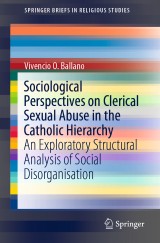Details

Sociological Perspectives on Clerical Sexual Abuse in the Catholic Hierarchy
An Exploratory Structural Analysis of Social DisorganisationSpringerBriefs in Religious Studies
|
58,84 € |
|
| Verlag: | Springer |
| Format: | |
| Veröffentl.: | 21.09.2019 |
| ISBN/EAN: | 9789811388255 |
| Sprache: | englisch |
Dieses eBook enthält ein Wasserzeichen.
Beschreibungen
<div><p>This book, as an exploratory sociological analysis, broadly examines the major structural factors which contribute to the social disorganization of the Catholic hierarchy as a clerical community, facilitating the persistence of clerical sexual abuse in the Catholic Church. Using some tenets of the social disorganization theory on crime and deviance as the overall theoretical framework with some perspectives from social organization, social network, and social capital, and secondary literature and qualitative data to support the arguments, it examines the (1) diocesan clergy’s social interaction, mutual support, and social control system in the hierarchical community, (2) connection between mandated clerical celibacy and clerical sexual abuse, and (3) the implication of the laity’s lack of empowerment and ecclesiastical authority to monitor and sanction clerical behavior. The Catholic hierarchy prides itself as a unified community of clerics under the Pope who shares the one priesthood of Christ. But the current clerical sexual scandals and the inability of bishops to adequately manage clerical sexual abuse cases make one wonders whether the Catholic clergy is indeed a cohesive and socially organized community which inhibits clerical sexual abuse. This book invites Church authorities, theologians, scholars, and lay leaders to understand the persistent clerical sexual abuse empirically and to come up with structural reforms which enhance the social network and social control systems of the Catholic hierarchy against clerical sexual misconduct and support victims.</p><br></div>
Preface.- 1.Introduction.- 2 The Catholic Hierarchy and Social Interaction of the Clergy.- <div><div>3. Supervision of Clerical Behavior in the Hierarchy.- 4.Celibacy and Social Disorganization in the Catholic Hierarchy.- 5.Lay Empowerment, Social Disorganization, and Clerical Sexual Abuse.</div></div>
<div>Dr. Vivencio O. Ballano was a diocesan and Jesuit seminarian for 10 years and Theology professor in Catholic universities for 12 years before becoming a sociologist. Currently, he is Associate Professor V of the Department of Sociology and Anthropology and College Researcher-Manager of the College of Social Science and Development (CSSD) of the Polytechnic University of the Philippines (PUP), Manila, Philippines. He received his doctorate in Sociology from the Ateneo de Manila University and master’s degree in Theology from the Loyola School of Theology (LST), Ateneo de Manila University. He is the author of the two Scopus-indexed books: Sociological Perspectives on Media Piracy in the Philippines and Vietnam (2016) and Law, Normative Pluralism, and Post-Disaster Recovery: Evaluating the Post-Disaster Relocation and Housing of Typhoon Ketsana Victims in the Philippines (2017), all published by Springer Nature Singapore. His research interests include sociology of law, religion, media piracy, post-disaster management, and Catholic Social Teaching. He is currently working on his next project, also a Springer Brief in Religious Studies under Springer Nature Singapore, on Catholic Social Teaching and the common good using the sociological approach.</div>
Takes a novel, exclusively sociological approach in analyzing the structural roots of clerical sexual abuse in the Catholic hierarchy as a clerical community Applies a social disorganization perspective to the current clerical sexual abuses in the Catholic Church Analyzes the disorganizing effects of mandatory clerical celibacy and weak lay participation to the Catholic hierarchy
This book offers an exploratory analysis of the major factors that contribute to the social disorganisation in the Catholic hierarchy as a clerical community, facilitating the persistence of clerical sexual abuse in the Catholic Church. Using social disorganisation theory as an overall theoretical framework, supported by secondary literature and qualitative data, it examines the social bonding and social control system in the hierarchical community, mandated clerical celibacy, as well as the lay participation in the monitoring and sanctioning of clerical abuses and their consequences to clerical behaviour. The Catholic Church prides itself on being a unified community of clerics under the Pope who shares the one priesthood of Christ. But ongoing clerical sexual scandals and the inability of bishops to adequately manage clerical abuse cases has engendered skepticism as to whether the Catholic clergy is indeed a cohesive and socially organised community that deters clerical abuse.To this end, this book explores the three structural areas that contribute to the social disorganisation of the Catholic hierarchy in policing clerical behaviour, namely: the lack of social interaction and cohesion of clerical life at the various levels of the hierarchy, the institutionally-mandated celibacy that deprives clerics of familial support and networks and direct social control of behaviour against sexual abuse, and the lack of lay authority and participation in the official Church governance and surveillance of priestly behaviour. This book invites Church authorities, academics, and lay leaders to understand persistent clerical sexual abuse empirically from a sociological perspective, and recommends structural reforms that might enhance the social network and social control systems of the Church. <div><br></div>
Diese Produkte könnten Sie auch interessieren:

Biblischer Hintergrund und Analyse der Sprachvielfalt in A. S. Byatts "Babel Tower"

von: Lars Hofer

15,99 €
















